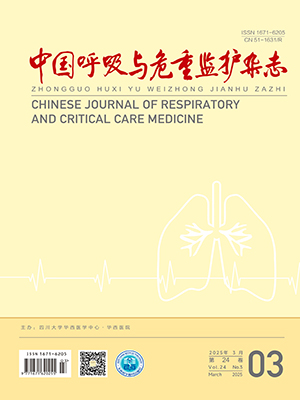| 1. |
中华医学会呼吸病学分会慢性阻塞性肺疾病学组, 中国医师协会呼吸医师分会慢性阻塞性肺疾病工作委员会. 慢性阻塞性肺疾病诊治指南(2021年修订版). 中华结核和呼吸杂志, 2021, 44(3): 170-205.
|
| 2. |
Brusselle G, Pavord ID, Landis S, et al. Blood eosinophil levels as a biomarker in COPD. Respir Med, 2018, 138: 21-31.
|
| 3. |
Hargreave FE, Dolovich J, Pizzichini E, et al. Airway eosinophilia in chronic bronchitis during exacerbations. Am J Respir Crit Care Med, 1996, 153(5): 1726-1727.
|
| 4. |
Global Strategy for the Diagnosis, Management, and Prevention of Chronic Obstructive PulmonaryDisease. Am J Respir Crit Care Med, 2021, 203(1): 24-36.
|
| 5. |
Bafadhel M, McKenna S, Terry S, et al. Blood eosinophils to direct corticosteroid treatment of exacerbations of chronic obstructive pulmonary disease: a randomized placebo-controlled trial. Am J Respir Crit Care Med, 2012, 186(1): 48-55.
|
| 6. |
Antus B, Paska C, Barta I. Predictive value of exhaled nitric oxide and blood eosinophil count in the assessment of airway eosinophilia in COPD. Int J Chron Obstruct Pulmon Dis, 2020, 15: 2025-2035.
|
| 7. |
Hospers JJ, Schouten JP, Weiss ST, et al. Eosinophilia is associated with increased all-cause mortality after a follow-up of 30 years in a general population sample. Epidemiology, 2000, 11(3): 261-268.
|
| 8. |
Zeiger RS, Tran TN, Butler RK, et al. Relationship of blood eosinophil count to exacerbations in chronic obstructive pulmonary disease. J Allergy Clin Immunol Pract, 2018, 6(3): 944-954.e5.
|
| 9. |
Bafadhel M, Mckenna S, Terry S, et al. Acute exacerbations of chronic obstructive pulmonary disease: identification of biologic clusters and their biomarkers. Am J Respir Crit Care Med, 2011, 184(6): 662-671.
|
| 10. |
Brightling CE, Monteiro W, Ward R, et al. Sputum eosinophilia and short-term response to prednisolone in chronic obstructive pulmonary disease: a randomised controlled trial. Lancet, 2000, 356(9240): 1480-1485.
|
| 11. |
Landis S, Suruki R, Maskell J, et al. Demographic and clinical characteristics of COPD patients at different blood eosinophil levels in the UK Clinical Practice Research Datalink. COPD, 2018, 15(2): 177-184.
|
| 12. |
费凡, 吴桢珍, 朱曼旎, 等. 血嗜酸性粒细胞在慢性阻塞性肺疾病急性加重中的临床意义. 中国呼吸与危重监护杂志, 2019, 18(5): 418-422.
|
| 13. |
金晓晴, 陈波, 王颖, 等. 外周血嗜酸粒细胞对重症慢阻肺急性加重期患者疗效及预后评价的研究. 武汉大学学报(医学版), 2017, 38(3): 475-478.
|
| 14. |
邓火金, 孙滨. 糖皮质激素对哮喘患者CD4 T淋巴细胞和嗜酸细胞活化的影响. 中华内科杂志, 1997, 36(1): 7-10.
|
| 15. |
Pascoe S, Barnes N, Brusselle G, et al. Blood eosinophils and treatment response with triple and dual combination therapy in chronic obstructive pulmonary disease: analysis of the IMPACT trial. Lancet Respir Med, 2019, 7(9): 745-756.
|
| 16. |
Lipson DA, Barnhart F, Brealey N, et al. Once-daily single-inhaler triple versus dual therapy in patients with COPD. N Engl J Med, 2018, 378(18): 1671-1680.
|
| 17. |
Lipworth B, Kuo CR, Jabbal S. Inhaled triple therapy in chronic obstructive pulmonary disease. Lancet, 2018, 392(10153): 1112-1113.
|
| 18. |
Pascoe S, Locantore N, Dransfield MT, et al. Blood eosinophil counts, exacerbations, and response to the addition of inhaled fluticasone furoate to vilanterol in patients with chronic obstructive pulmonary disease: a secondary analysis of data from two parallel randomised controlled trials. Lancet Respir Med, 2015, 3(6): 435-442.
|
| 19. |
Jo YS, Kim SK, Park SJ, et al. Longitudinal change of FEV1 and inspiratory capacity: clinical implication and relevance to exacerbation risk in patients with COPD. Int J Chron Obstruct Pulmon Dis, 2019, 14: 361-369.
|




